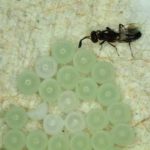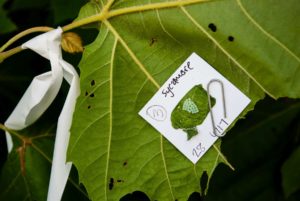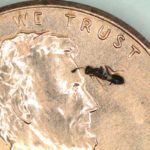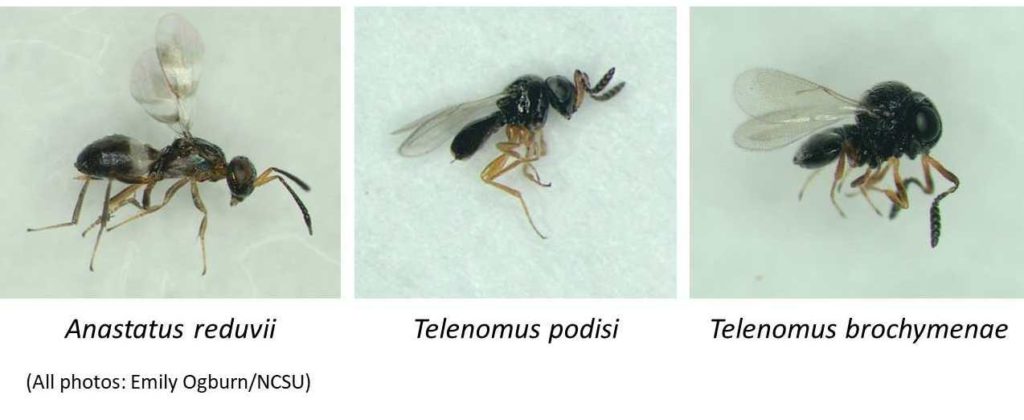Biological Control of Brown Marmorated Stink Bug
go.ncsu.edu/readext?669080
en Español / em Português
El inglés es el idioma de control de esta página. En la medida en que haya algún conflicto entre la traducción al inglés y la traducción, el inglés prevalece.
Al hacer clic en el enlace de traducción se activa un servicio de traducción gratuito para convertir la página al español. Al igual que con cualquier traducción por Internet, la conversión no es sensible al contexto y puede que no traduzca el texto en su significado original. NC State Extension no garantiza la exactitud del texto traducido. Por favor, tenga en cuenta que algunas aplicaciones y/o servicios pueden no funcionar como se espera cuando se traducen.
Português
Inglês é o idioma de controle desta página. Na medida que haja algum conflito entre o texto original em Inglês e a tradução, o Inglês prevalece.
Ao clicar no link de tradução, um serviço gratuito de tradução será ativado para converter a página para o Português. Como em qualquer tradução pela internet, a conversão não é sensivel ao contexto e pode não ocorrer a tradução para o significado orginal. O serviço de Extensão da Carolina do Norte (NC State Extension) não garante a exatidão do texto traduzido. Por favor, observe que algumas funções ou serviços podem não funcionar como esperado após a tradução.
English
English is the controlling language of this page. To the extent there is any conflict between the English text and the translation, English controls.
Clicking on the translation link activates a free translation service to convert the page to Spanish. As with any Internet translation, the conversion is not context-sensitive and may not translate the text to its original meaning. NC State Extension does not guarantee the accuracy of the translated text. Please note that some applications and/or services may not function as expected when translated.
Collapse ▲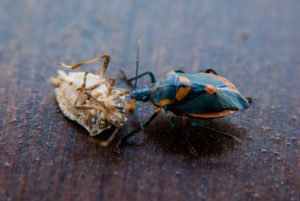
A Florida predatory stink bug, Euthyrhynchus floridanus, attacks a brown marmorated stink bug. (Photo: Steve Schoof/NCSU)
Background
Biological control through natural enemies has the potential to suppress brown marmorated stink bug (Halyomorpha halys, BMSB) populations over a large landscape scale. Natural enemies include predators (beneficial insects that eat a pest or its eggs) and parasitoids (insects that lay their offspring in, on, or near a host pest or its eggs, resulting in the offspring developing and feeding on the pest). Both types of natural enemies kill at least one life stage of the pest.
In its native Asia, BMSB is not a major pest, partly because tiny wasp parasitoids destroy large numbers of BMSB eggs. These parasitoids can lay their offspring inside the eggs of insects, including brown marmorated stink bugs. Asian parasitoids were not present in North America when BMSB was accidentally introduced, so BMSB was able to spread unchecked.
Research Projects
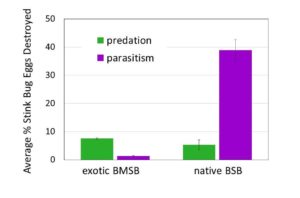
The effects of native predators and parasitoids on the exotic brown marmorated stink bug (BMSB) versus the native brown stink bug (BSB). Citation
There are a number of predators and parasitoids in North America that effectively control native stink bugs, but in most areas they have only a limited impact on populations of the exotic brown marmorated stink bug. However, we continue to study these native natural enemies in hopes of improving their effectiveness in controlling BMSB.
NATIVE PREDATORS: Research by other labs in the southeast and mid-Atlantic have identified a wide variety of generalist predators that consume BMSB eggs. The list includes certain species of crickets, katydids, ground beetles, lady beetles, earwigs, ants, assassin bugs, mantids, and jumping spiders, as well as less familiar insects such as minute pirate bugs, lacewings, and damsel bugs. To monitor predator populations in North Carolina, we deploy yellow sticky cards for one-week periods in both managed and non-managed landscapes. Cards are returned to the lab and all significant specimens are recorded.
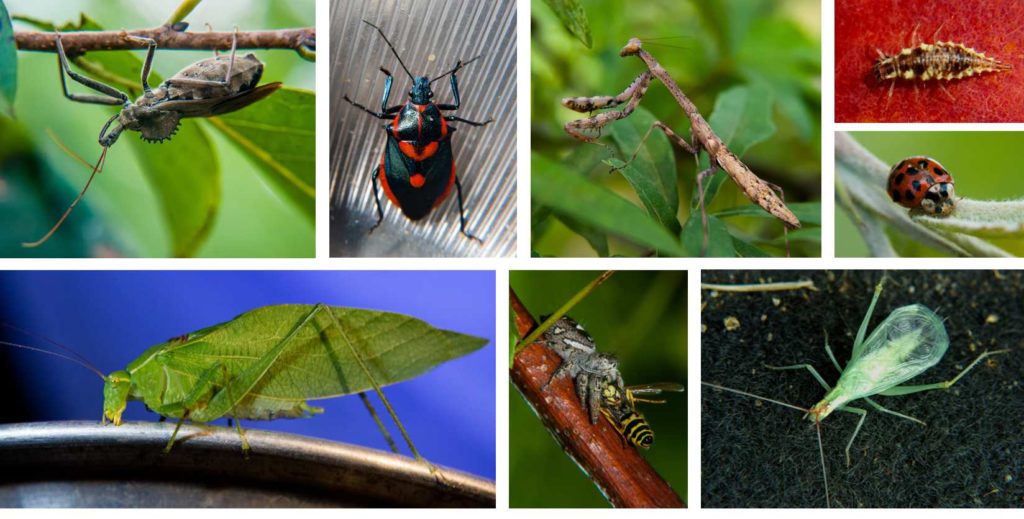
Some native predators of BMSB or BMSB eggs. Clockwise from top left: assassin bug, Florida predatory stink bug, praying mantis, lacewing larva, lady beetle, tree cricket, jumping spider, katydid. (All photos: Steve Schoof/NCSU)
NATIVE PARASITOIDS: Parasitoids are monitored with both sticky cards and laboratory-produced “sentinel” BMSB egg masses, which are placed on a variety of host trees and crops. Sentinel egg masses are collected and brought back to the lab before any BMSB or parasitoids hatch. Any parasitoids that hatch from sentinel eggs are identified to species. So far, only native species of parasitoids have been detected in North Carolina:
- Anastatus reduvii
- Anastatus mirabilis
- Ooencyrtus sp.
- Telenomus podisi
- Trissolcus brochymenae
- Trissolcus edessae
- Trissolcus euschisti
- Trissolcus thyantae
Telenomus podisi is plentiful in North Carolina but is not very successful at parasitizing brown marmorated stink bug eggs, although it readily parasitizes and hatches from the eggs of a native pest, the brown stink bug. In the lab, Anastatus reduvii parasitizes all the BMSB eggs that are given to it, but it parasitizes only a very small percentage of sentinel BMSB eggs placed in the field. A. reduvii lives in wooded habitats and therefore rarely encounters BMSB eggs laid in or near crops. We are further studying the biology of A. reduvii and investigating the potential of this native parasitoid for more successful control of BMSB in the future. xxxxxxxxxxxx

Trissolcus japonicus, also known as the samurai wasp, an exotic natural enemy of BMSB. (Photo: Elijah Talamas/ARS-USDA)
TRISSOLCUS JAPONICUS: Our lab has also discovered the natural expansion of an exotic parasitoid, Trissolcus japonicus, into North Carolina. Also called the “Samurai wasp,” this stingerless, flea-sized parasitoid (<1-2mm long) coevolved with BMSB in Asia and is much more effective at controlling BMSB than native North American parasitoids and predators. In 2014, T. japonicus was found in the US through accidental introduction, presumably having arrived with BMSB. It has since been found in the wild in thirteen states and is being studied in quarantine at USDA facilities. By law, T. japonicus may be released in states only where it has been found naturally. Since discovering T. japonicus in NC, we hope to begin researching the best ways to harness its potential as a biological control agent, just as states like Michigan have been doing.
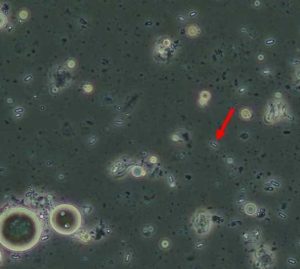
Spores of Nosema maddoxi, a microsporidian, infecting an adult BMSB. Spores are the small, cylindrical, capsule-shaped objects, one of which is indicated by the red arrow. Photograph taken using a microscope with phase-contrast at 40x. (Photo: Emily Ogburn)
NEITHER PREDATOR NOR PARASITOID — NOSEMA MADDOXI: Nosema maddoxi, a species of microsporidian, infects BMSB. Microsporidia species can negatively impact their insect host in many ways, including: shortening the insect’s life span, reducing the amount of eggs females lay, and reducing egg viability. Nosema maddoxi only infects four stink bug pests: BMSB, brown stink bugs (Euschistus servus), dusky stink bugs (Euschistus tristigmus), and green stink bugs (Chinavia hilaris). This microsporidian species produces spores which then infect healthy stink bugs, usually after healthy bugs ingest the spores while feeding on infected bugs (dead bugs, eggs, etc.) or on the feces of an infected bug. Further research on the effects of Nosema maddoxi on BMSB and its distribution and prevalence in wild populations of stink bugs is underway.

Cage containing A. reduvii wasp parasitoids. Corks allow insertion of test tube containing food (10% sugar water) and BMSB egg masses for parasitization. (Photos: Emily Ogburn/NCSU)
LABORATORY COLONIES: We also rear lab colonies of native wasp parasitoids (primarily A. reduvii) for continued research into their ecology and biology. We are researching differences in parasitoid and predator control of BMSB eggs in different crops in North Carolina, and we have performed bioassays on the effects of organic pesticides on native parasitoids. Future research will focus on understanding how management practices can increase natural enemy effectiveness in North Carolina agricultural systems.
Additional resources
- Vegetable Pest Management
- Apple Pest Management
- Biological Control with Predators and Parasitoids
- Brown Marmorated Stink Bug in North Carolina
- Walgenbach Entomology Lab
- StopBMSB
*Chart reprinted from Biological Control Vol.101, Ogburn, E. C., R. Bessin, C. Dieckhoff, R. Dobson, M. Grieshop, K. A. Hoelmer, C. Mathews, J. Moore, A. L. Nielsen, K. Poley, J. M. Pote, M. Rogers, C. Welty, and J. F. Walgenbach, Natural enemy impact on eggs of the invasive brown marmorated stink bug, Halyomorpha halys (Stal) (Hemiptera: Pentatomidae), in organic agroecosystems: A regional assessment, 39-51, Copyright (2016), with permission from Elsevier.



